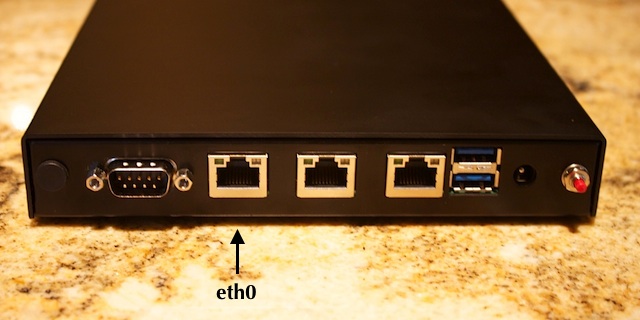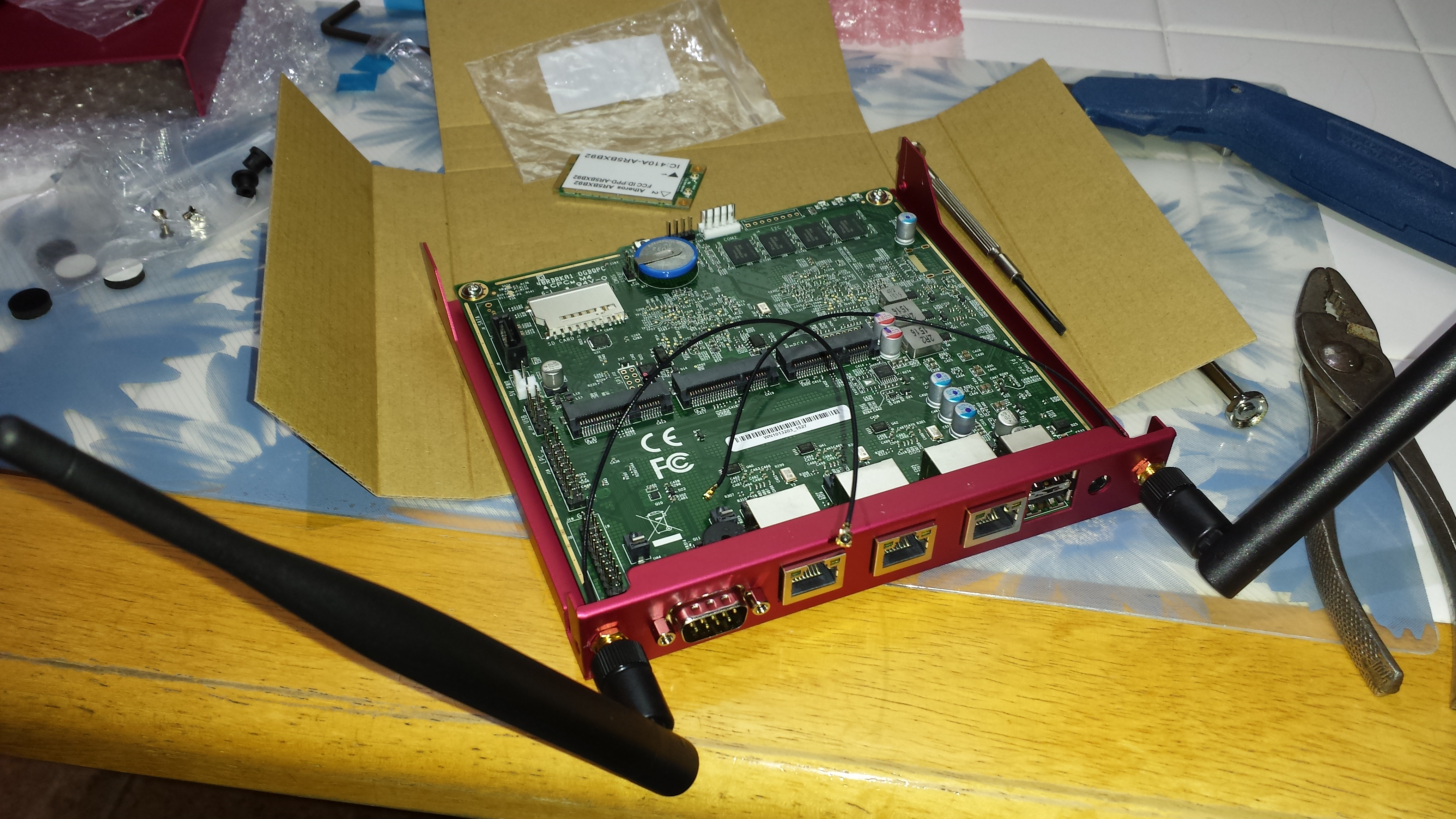Pc Engines Apu Serial Console For Mac
@@ -19,7 +19,7 @@ Note: Some of the steps require downloading software. Whenever possible, verify Pigtail cable I-PEX - reverse SMA PC Engines pigsma( 2 x $1.5 Antenna reverse SMA dual band PC Engines antsmadb( 2 x $2.05 Null modem cable DB9-F to DB9-F PC Engines, anywhere db9cab1( $1.3 USB to RS-232 DM9-M adapter Sabrent (FTDI) USB-2920( $ 10.11 USB to RS-232 DM9-M adapter PC Engines, Sabrent (FTDI) usbcom1a(USB-2920( $ 8-10 8GB USB Flash Drive Amazon, anywhere CZ50( $4.29 Total $202.68 without shipping.
@@ -32,13 +32,15 @@ Assemble the hardware per the instructions on the PC Engines website. Remember: ## Setup serial console Note that the serial port settings for the APU2 are 115200 baud rate, 8N1 (8 data bits, no parity, 1 stop bit). Connect the APU serial port to another machine. This can be done several ways: 1. Install the USB to serial driver(2.
Plug the USB end of the USB to serial cable to the Mac 3. Plug the DB9-M end of the USB to serial cable to one end of the null modem cable 4. Plug the other end of the null modem cable to the APU2 5. Connect to the APU2 from the terminal: `screen /dev/tty.usbserial 115200` (note: your device might be different, look for devices with `tty` and `serial` in their name) + If you have a serial port, you can connect it directly to the APU with a null modem cable(+ You can use a USB-to-serial(adapter at your machine, with a null modem cable(and its driver(+ Or use the PCEngines adapter(with a regular USB cable. The serial port settings for the APU2 are 115200 baud rate, 8N1 (8 data bits, no parity, 1 stop bit). Connect from a terminal: `screen /dev/tty.usbserial 115200` Your device might be different; look in `/dev` for devices with `tty` and `serial` in their name, or check dmesg.
Power the APU2 off and back on by pulling the plug and plugging it back in, respectively. You should see output on the screen. Toggle all file notes. Add this suggestion to a batch that can be applied as a single commit. This suggestion is invalid because no changes were made to the code. Suggestions cannot be applied while the pull request is closed. Suggestions cannot be applied while viewing a subset of changes.

Only one suggestion per line can be applied in a batch. Add this suggestion to a batch that can be applied as a single commit. Applying suggestions on deleted lines is not supported. You must change the existing code in this line in order to create a valid suggestion. Outdated suggestions cannot be applied. This suggestion has been applied or marked resolved. Suggestions cannot be applied from pending reviews.
I started writing this article on 10th January, 2015. But I didn’t have so much time to finish it Now time has come, so I decided to finish this work and publish it. Many time has passed by, and many things have changed. A new ESXi version has been carried out, and new APU hardware is coming soon. But I think that this article can be a good starting point also for headless installation of new ESXi and other.nix based headless devices.
Unfortunately installation was not successfully, or better speaking installation correctly ended, but device didn’t turned up as I expected it would. I attempted many ways to overcome this problem, but I haven’t found any of them to correctly work. I posted all of this history here, in the hope that someone would find what I missed.
Introduction In this article I’m introducing a step by step guide on how to install ESXi 5.5 U2 on board. Apu1d4 is a small computer board that can be used for routers, firewalls, VOIP, dedicated servers, special purpose network plumbing, education tools It’s equipped with an AMD G series T40E, 1 GHz dual core with 64 bit support processor, 4GB RAM, three Gigabit Ethernet ports and a serial console. You can read all of its specification. This setup guide it’s also suitable to install many other Linux distributions.
Prerequisites As apu1d4 does not have a video output, setup must be performed via serial console. This is the major issue when installing ESXi, as the plain setup is intended to be used with a video card. But as it is Linux-based, we can turn on the serial console redirection to handle all of the setup process from here. In this guide I’m assuming to install ESXi on a mSATA SSD installed on the board. Please make sure the SSD is detected by board BIOS before starting the setup process (you should see your mSATA ID into the BIOS boot messages on the serial console). You need the following hardware:.
an apu1d4 board already boxed (for passive cooling to work), with an internal mSATA drive installed. an empty USB pen drive (at least 1GB). a null modem cable.
a PC with a serial port or a USB to serial converter (you may omit the null modem cable if you use a USB to DCE converter like, that is intended to be used to connect directly to a console port) and the following software:. ESXi 5.5 U2 install ISO (you don’t need to burn it onto a CD). a utility to create a bootable USB key from an ISO.
There are many utilities to do that; here I’m using. a serial communication software which allows you to connect to console port; here I’m using. a utility to open.zip files; here I’m using.

a general purpose text editor; here I’m using. the two file contained into this ESXi setup patch: A note on the patch: apu1d4 board integrates three Gigabit Ethernet channels based on the Realtek RTL8111E chipset. As RTL8111E support has been removed from ESXi setup since version 5.5, but it was still present in 5.1 setup, we need to extract the drivers from 5.1 installer and integrate them into the 5.5 one. This is needed as without installing and activating the drivers, you will end your setup into a “No network hardware detected” screen. How to integrate this driver in the setup is better explained later. Step by step guide Installation process can be resumed in the following steps:. create ESXi 5.5 U2 USB boot pen drive (called pen drive in the following steps).

unpack ISO to pen drive and make it bootable. patch pen drive to load RTL8111 drivers. patch pen drive to work with serial console. install ESXi. finalize setup Create ESXi 5.5 U2 USB boot pen drive Any tool you can find to extract an ISO image to a pen drive and make it bootable is suitable to create ESXi setup pen drive. I found to be easy and clear to use. It’s also OpenSource and sources can be grabbed from it’s home page.
From Rufus main window you have to select the USB drive related to the pen drive you want to use, the partitioning method (usually the default value is correct) and obviously the ESXi ISO image to store on key. If should be warned that the menu.c32 file which comes on the ISO is obsolete and you should substitute it with a freshly downloaded version. Please accept this suggestion and let Rufus patch this file.
You should end up in few minutes with the key ready to be patched. Patch pen drive to load RTL8111 drivers As said ESXi 5.5 U2 setup does not include RTL8111 drivers. If you do not patch the pen drive with those drivers, installation cannot be performed and you’ll receive a “No network card present” message.
Usually drivers can be added later installing the so called VIB packages, but as the network card is considered to be part of the core setup, if no network card can be detected during setup phase, process will be stopped. To avoid this problem a clean and correct way should be to install ESXi 5.1 version and then perform a version upgrade, but this could take long.
A faster-and-quite-clean method is to include ESXi 5.1 drivers directly on 5.5 U2 setup, and that’s what we are going to do now. When googling around this problem you’ll find several.vib files packaged into a.zip file, that should unpack to upload.vibs to your ESXi machine.
Pc Engines Apu Serial Console For Mac Pro
Basically each.vib file is in turn a.zip package, containing the driver(s) itself and some descriptors. I simply extracted and repacked the two drivers included in the following.vib: VMwarebootbanknet-r81688.013.00-3vmw.510.0.0.799733.vib VMwarebootbanknet-r81696.011.00-2vmw.510.0.0.799733.vib into a single.zip file that you’ll find attached. All you have to do is to download the.zip containing the two drivers (net-r816.v00 and net-r816.v01) and extract them onto the pen drive, in its root directory.
After that you have to edit the boot.cfg file located on the pen drive, and add those driver to load list. To do so open your favorite editor (be carefull: you should not use NotePad because it lacks support for UNIX style line endings; you’d better use a general purpose editor like ). Locate the row modules=/b.b00 -. And then add the following in your favorite position (I added them after all of the netxxx drivers): - /net-r816.v00 - /net-r816.v01 Save the file and you’re done with the patch.
Patch pen drive to work with serial console In the last preparation step we have to patch configuration files to tell loader and setup to redirect standard output and standard input over a serial console. This step involves editing three configuration files, that must be still edited with the general purpose editor. Syslinux.cfg Patching this file only requires you to add the following two lines AT TOP of the file: CONSOLE 0 SERIAL 0 115200 isolinux.cfg Patching this file requires you to add the following two lines AT TOP of the file: CONSOLE 0 SERIAL 0 115200 Then you have to locate the line APPEND -c boot.cfg located in the LABEL install section of the configuration. At the end of the line you have to add the extra parameters needed to instruct loader to redirect standard input and output. Line should look like this: APPEND -c boot.cfg text gdbPort=none logPort=none tty2Port=com1 boot.cfg You have again to patch boot.cfg, as done in the step before. Modification involves the kernel option parameter passed; you have to locate the line kernelopt=runweasel and add the extra parameters needed to redirect standard input and output. Line should look like this: kernelopt=runweasel text nofb com1baud=115200 com1Port=0x3f8 tty2Port=com1 gdbPort=none logPort=none Install ESXi You are now ready to start ESXi setup.
Put the pen drive into the USB port, connect your PC to the console port, start PuTTY and power up the board. Hello All, Thanks for this excellent article. I achieved to install esxi on my APU 1d4. I followed all the steps, including the last step that required to boot with the tinycore and update the boot.cfg. I have to note that while the installation was completed, the first time that I booted the device I got a message that it could find any network adapter.
Pc Engines Apu Serial Console For Macbook
So I booted again using the tinycore and apply the patch for the drivers for a second time (the first was for the installation). Now it works perfectly. Thanks again.